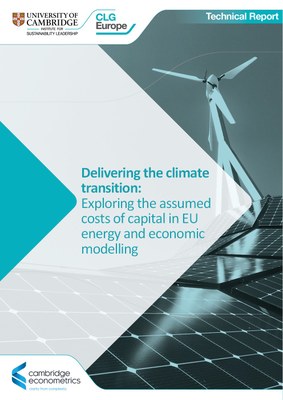31 March 2021 - The new CLG Europe technical report indicates the cost of finance assumptions used in EU modelling could be overestimating the cost and level of policy action needed to achieve the EU’s 2030 climate goals.
About
Research commissioned by the CLG Europe analysed the assumptions within the EU’s economic and energy modelling that is informing the revisions to its climate legislation. Modelling of policy packages required to mobilise investment in low carbon technology is based on assumptions of a blanket 10% interest rate on borrowing and high discount rates.*
The report states the 10% interest rate used by the EU in its macroeconomic modelling is 'too high in the current context' and biases the results in favour of a high carbon future. It also obscures the fact the lifetime cost of low-carbon technologies may be lower.
The new report provides recommendations on how the EU could improve its modelling assumptions taking into consideration real world known conditions. Although the EU has world-leading modelling, it is critical to address whether the modelling that forms the backbone of the new ambition is in line with current macroeconomic conditions, including how different technologies are financed, and whether it is taking into account how effective policy can be in de-risking investments.
Key findings of the report:
The analysis carried out by Cambridge Econometrics explored the impacts of discount and interest rate assumptions across three key sectors: transport, power and heating, and reviewed the level of interest rates across four European countries. The key findings of the report are the following:
- “The discount rate and interest rate assumptions matter. A transition to a low carbon economy requires relatively more capital-intensive investment across all sectors of the economy than renewing high carbon technologies. Although the higher capital costs of low carbon technologies are (offset by lower running costs in most cases, the higher capital intensity (up-front cost) of low carbon technology options means that a higher interest rate assumption increases the relative cost of low carbon technologies.”
- “The interest rate assumption of 10 per cent that is applied to calculate the annualised cost of capital in the economic modelling is too high in the current context of sustained low interest rates across Europe. We find evidence that market rates available to governments, businesses and even households are often significantly below the 10 per cent assumption.”
- Higher discount rates in the energy system modelling mean that stronger policies are required to reach a given reduction target. A lower discount rate assumption would show that a more ambitious emissions reduction could be achieved with the same policy mix.
- “The policies put in place to meet climate and energy goals can reduce investment risk and change the rate of return required by businesses and households to make investments.”
- The report also provides recommendations on how future analysis can be improved.
Harry Verhaar, Chair of CLG Europe, and Head of Global Public & Government Affairs, Signify said:
“Having accurate assumptions for discount rates in economic modelling of transitioning to low carbon energy in Europe is pivotal as too high cost of finance assumptions can undermine the scale and pace needed to achieve the EU’s emission reduction targets. Businesses and households would profit from properly estimated interest rates and discount rates that reflect well the future value creation of low carbon technologies and how they consistently outweigh the capital investment. Policymakers have a crucial role in mitigating investment risks to accelerate the transition to a climate neutral Europe.
Mirella Vitale, Senior Vice President, ROCKWOOL Group said:
“In the same way as products won’t sell if they’re not correctly priced, the Commission must use up-to-date methodology when estimating the investment needs of the EU’s 2030 climate and energy policies. Otherwise – if the Commission keeps on using a 10% interest rate – cost estimates will be too high and it will be harder to convince member states to support more ambitious goals.”
Philip Summerton, CEO, Cambridge Econometrics said:
“George E.P. Box famously said ‘All models are wrong but some are useful’. The modelling that the Commission undertakes in its assessment of energy and climate policies is extremely useful to all stakeholders in helping to understand and shape Europe’s response to the net zero challenge. By improving the treatment of interest rates in the economic modelling the Commission can further build confidence in its approach.”
Ursula Woodburn, Head of EU Relations, CLG Europe said:
"At this crucial moment when ambition and commitment on climate change need to be as high as possible to ensure a stable future, it is vital modelling informing investment and policy decisions draws on cutting-edge understanding of financing and investment.
Decision-making around the EU's climate ambition in 2030 and the economic recovery packages will be shaped by assumptions over the costs and benefits of different actions. The right assumptions in modelling can provide confidence on the pathway to rapid emissions cuts and demonstrate how the low carbon transition offers an economically, socially and environmentally positive future."
Beverley Cornaby, Senior Programme Manager, The Prince of Wales’s Corporate Leaders Group said:
"As the UK embarks on a new ‘green industrial revolution’ and designs policies to deliver on a green recovery and its enhanced 2030 targets, the UK government should ensure it is making its decisions based on the best available information. This should include more refined economic modelling that could be beneficial in making the case for more ambitious climate action in the UK."
*Discount rates are used to reflect a preference for having benefits today rather than benefits in the future.
Citing this report
University of Cambridge Institute for Sustainability Leadership (CISL). (2021). Delivering the climate transition: Exploring the assumed costs of capital in EU energy and economic modelling. Technical Report. Cambridge, UK: CLG Europe.
Read more thought leadership from the Corporate Leaders Groups.
Learn more about CLG Europe's engagement with policymakers.


